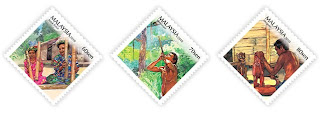Lifestyle of the Aboriginal People of Malaysia
Malaysia's indigenous communities represent a small but important part of the nation's multi-cultural milieu. These communities are disproportionately spread out between the small and frequently isolated communities found in the peninsular and the Malaysian Borneo states of Sarawak and Sabah where they make up 50 to 60 percent of the respective state's population. 
The "Orang Asli" are made up of nearly a hundred different ethnic sub-groups. These include around twenty in Peninsular Malaysia although administratively, they are categorised as Negrito, Senoi and Aboriginal Malay. Sabah and Sarawak, on the other hand, has between 30 to 40 distinct sub-groups each with an even more amazing number of languages and dialects.
The Department of Orang Asli Affairs or JHEOA is entrusted with the care and administration of the indigenous communities. Its mandate includes the eradication of poverty, improvement of health, promoting education and improving their general livelihood and where possible and desired, their integration with mainstream Malaysian society.
The Proto Malays
The 60 sen stamp portrays two women of the Proto-Malay tribe playing a traditional musical instrument known as the "Ketuk Buluh" or a slotted bamboo pipe previously used to scare away birds during the harvesting season. It is nowadays mostly used as a musical instrument for community dances including weddings, the arrival of guests and so on.
The Negrito
A Negrito man hunting with his blowpipe adorns the 70 sen stamp. Silent and highly accurate in the hands of an expert, it fires poisoned darts and is well suited for shooting birds, monkeys and other small animals out of trees. Primarily hunter-gathers, the Negrito people subsist on the bounty of Peninsular Malaysia's abundant rainforests for food as well as shelter.
The Senoi
A native of the Senoi tribe is depicted on the 80 sen stamp applying his skills at woodcarving. Well known for their woodworking abilities, the Senoi most often sculpt spirit gods and effigies that are used both for worship as well as decoration. The "harimau berantai" (a mythical tiger holding a chain in its mouth) is their most popular artistic choice.
Isnin, 13 Disember 2010
Lifestyle of the Aboriginal People of Malaysia
Langgan:
Catat Ulasan (Atom)




















Tiada ulasan:
Catat Ulasan